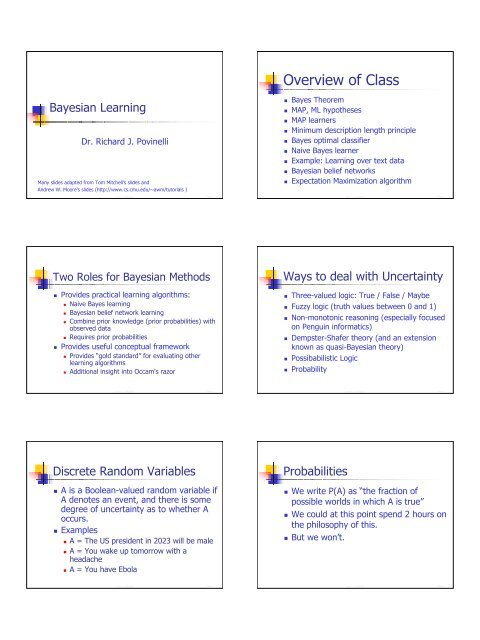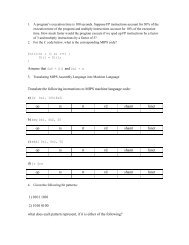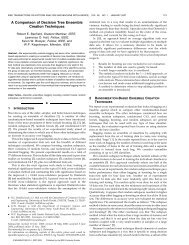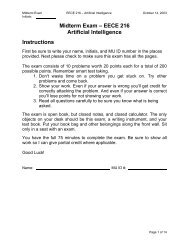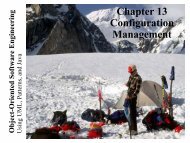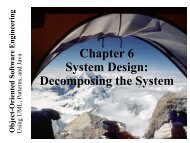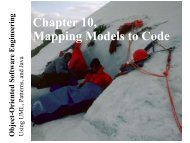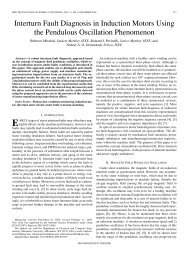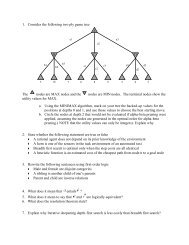Bayesian Learning Handouts.pdf - Richard J. Povinelli
Bayesian Learning Handouts.pdf - Richard J. Povinelli
Bayesian Learning Handouts.pdf - Richard J. Povinelli
Create successful ePaper yourself
Turn your PDF publications into a flip-book with our unique Google optimized e-Paper software.
<strong>Bayesian</strong> <strong>Learning</strong><br />
Dr. <strong>Richard</strong> J. <strong>Povinelli</strong><br />
Many slides adapted from Tom Mitchell’s slides and<br />
Andrew W. Moore’s slides (http://www.cs.cmu.edu/~awm/tutorials )<br />
rev 1.0, 1/20/2003<br />
Two Roles for <strong>Bayesian</strong> Methods<br />
Page 1<br />
� Provides practical learning algorithms:<br />
� Naive Bayes learning<br />
� <strong>Bayesian</strong> belief network learning<br />
� Combine prior knowledge (prior probabilities) with<br />
observed data<br />
� Requires prior probabilities<br />
� Provides useful conceptual framework<br />
� Provides “gold standard” for evaluating other<br />
learning algorithms<br />
� Additional insight into Occam's razor<br />
rev 1.0, 1/20/2003<br />
Discrete Random Variables<br />
� A is a Boolean-valued random variable if<br />
A denotes an event, and there is some<br />
degree of uncertainty as to whether A<br />
occurs.<br />
� Examples<br />
� A = The US president in 2023 will be male<br />
� A = You wake up tomorrow with a<br />
headache<br />
� A = You have Ebola<br />
rev 1.0, 1/20/2003<br />
Page 3<br />
Page 5<br />
Overview of Class<br />
� Bayes Theorem<br />
� MAP, ML hypotheses<br />
� MAP learners<br />
� Minimum description length principle<br />
� Bayes optimal classifier<br />
� Naive Bayes learner<br />
� Example: <strong>Learning</strong> over text data<br />
� <strong>Bayesian</strong> belief networks<br />
� Expectation Maximization algorithm<br />
rev 1.0, 1/20/2003<br />
Ways to deal with Uncertainty<br />
� Three-valued logic: True / False / Maybe<br />
� Fuzzy logic (truth values between 0 and 1)<br />
� Non-monotonic reasoning (especially focused<br />
on Penguin informatics)<br />
� Dempster-Shafer theory (and an extension<br />
known as quasi-<strong>Bayesian</strong> theory)<br />
� Possibabilistic Logic<br />
� Probability<br />
Probabilities<br />
rev 1.0, 1/20/2003<br />
� We write P(A) as “the fraction of<br />
possible worlds in which A is true”<br />
� We could at this point spend 2 hours on<br />
the philosophy of this.<br />
� But we won’t.<br />
rev 1.0, 1/20/2003<br />
Page 2<br />
Page 4<br />
Page 6
Event space of<br />
all possible<br />
worlds<br />
Its area is 1<br />
Visualizing A<br />
Worlds in which<br />
A is true<br />
Worlds in which A is False<br />
rev 1.0, 1/20/2003<br />
Interpreting the axioms<br />
� 0
Theorems from the Axioms<br />
� Axioms<br />
� 0
Bayes Rule<br />
P ( A∧B) P ( B A)<br />
=<br />
P ( A)<br />
P ( A B) P ( B)<br />
=<br />
P ( A)<br />
Bayes, Thomas (1763) An essay<br />
towards solving a problem in the doctrine<br />
of chances. Philosophical Transactions<br />
of the Royal Society of London, 53:370-<br />
418<br />
rev 1.0, 1/20/2003<br />
Using Bayes Rule to Gamble<br />
$1.00<br />
The “Win” envelope has<br />
a dollar and four<br />
beads in it<br />
rev 1.0, 1/20/2003<br />
The “Lose” envelope has<br />
three beads and no<br />
money<br />
Interesting question: before deciding, you are allowed to see one bead<br />
drawn from the envelope.<br />
Suppose it’s black: How much should you pay?<br />
Suppose it’s red: How much should you pay?<br />
Choosing Hypotheses<br />
P ( D h) P ( h)<br />
P ( h D)<br />
=<br />
P ( D)<br />
Generally want the most probable hypothesis given the training data<br />
Maximum a posteriori hypothesis hMAP<br />
hMAP = argmax P ( h D)<br />
h∈H P ( D h) P ( h)<br />
= argmax<br />
h∈H P ( D)<br />
= argmax P ( D h) P ( h)<br />
h∈H If assume P ( hi) = P ( hj)<br />
then can further simplify,<br />
and choose the<br />
Maximum likelihood (ML) hypothesis<br />
hML = argmax P ( D hi)<br />
hi∈H rev 1.0, 1/20/2003<br />
Page 19<br />
Page 21<br />
Page 23<br />
Using Bayes Rule to Gamble<br />
$1.00<br />
R R B B R B B<br />
The “Win” envelope has<br />
a dollar and four<br />
beads in it<br />
rev 1.0, 1/20/2003<br />
The “Lose” envelope<br />
has three beads and<br />
no money<br />
Trivial question: someone draws an envelope at random and offers to<br />
sell it to you. How much should you pay?<br />
Classroom Activity<br />
� Suppose it’s black: How much should<br />
you pay?<br />
� Suppose it’s red: How much should<br />
you pay?<br />
� With a partner figure out how you<br />
represent each of these. You have 5<br />
minutes.<br />
rev 1.0, 1/20/2003<br />
Bayes Theorem<br />
� Does patient have cancer or not?<br />
� A patient takes a lab test and the result comes back positive.<br />
The test returns a correct positive result in only 97% of the<br />
cases in which the disease is actually present, and a correct<br />
negative result in only 98% of the cases in which the<br />
disease is not present. Furthermore, 0.007 of the entire<br />
population have this cancer.<br />
� Probabilities<br />
� P(cancer) =<br />
� P(¬cancer) =<br />
� P(+ | cancer) =<br />
� P(- | cancer) =<br />
� P(+ | ¬cancer) =<br />
� P(- | ¬cancer) =<br />
rev 1.0, 1/20/2003<br />
Page 20<br />
Page 22<br />
Page 24
Brute Force MAP<br />
Hypothesis Learner<br />
1. For each hypothesis h ∈ H,<br />
calculate<br />
the posterior probability<br />
( )<br />
( )<br />
P ( D)<br />
( )<br />
P D h P h<br />
P h D =<br />
2. Output the hypothesis hMAP<br />
with the<br />
highest posterior probability<br />
h = argmax P h D<br />
MAP<br />
h∈H ( )<br />
rev 1.0, 1/20/2003<br />
Relation to Concept <strong>Learning</strong> II<br />
� Assume fixed set of instances <br />
� Assume D is the set of classifications<br />
D = < c (x1 ),…,c (xm )><br />
� Choose P (D |h)<br />
� P (D |h) = 1 if h consistent with D<br />
� P (D |h) = 0 otherwise<br />
� Choose P (h) to have a uniform distribution<br />
� P (h) = 1/|H| for all h in H<br />
� Then,<br />
⎧⎪<br />
⎪<br />
1<br />
if h is consistent with D<br />
P ( h D)<br />
= ⎪<br />
⎨VS H , D<br />
⎪⎪⎪⎩<br />
0 otherwise<br />
rev 1.0, 1/20/2003<br />
Characterizing <strong>Learning</strong> Algorithms<br />
by Equivalent MAP Learners<br />
rev 1.0, 1/20/2003<br />
Page 25<br />
Page 27<br />
Page 29<br />
Relation to Concept <strong>Learning</strong> I<br />
� Consider our usual concept learning task<br />
� instance space X, hypothesis space H, training<br />
examples D<br />
� consider the FindS learning algorithm (outputs<br />
most specific hypothesis from the version space<br />
VS H,D )<br />
� What would Bayes rule produce as the MAP<br />
hypothesis?<br />
� Does FindS output a MAP hypothesis??<br />
rev 1.0, 1/20/2003<br />
Evolution of Posterior Probabilities<br />
rev 1.0, 1/20/2003<br />
<strong>Learning</strong> A Real Valued Function<br />
� Consider any real-valued<br />
target function f<br />
� Training examples<br />
, where d i is a<br />
noisy training value<br />
� d i = f(x i ) + e i<br />
� e i is an independent random<br />
variable N(0,σ)<br />
� Then the maximum likelihood<br />
hypothesis h ML is the one that<br />
minimizes the sum of squared<br />
errors<br />
rev 1.0, 1/20/2003<br />
m<br />
argmin<br />
h∈H i = 1<br />
Page 26<br />
Page 28<br />
( ( ) ) 2<br />
hML = ∑<br />
di−h xi<br />
Page 30
<strong>Learning</strong> A Real Valued Function<br />
h∈ H i = 1<br />
h∈ H i = 1<br />
( )<br />
h = argmax p D h<br />
ML<br />
h∈H = argmax<br />
= argmax<br />
m<br />
∏<br />
m<br />
∏<br />
( i )<br />
p d h<br />
1<br />
2πσ<br />
rev 1.0, 1/20/2003<br />
2<br />
e<br />
( ) 2<br />
1⎛di<br />
−h x ⎞<br />
i<br />
− ⎜ ⎟<br />
⎜ ⎟<br />
2⎜⎜⎝<br />
σ<br />
⎟<br />
⎠⎟<br />
<strong>Learning</strong> to Predict Probabilities<br />
� Consider predicting survival probability from patient data<br />
� Training examples < x i , d i >, where d i is 1 or 0<br />
� Want to train neural network to output a probability given x i<br />
(not a 0 or 1)<br />
� In this case can show<br />
hML = argmax ∑dilnh(<br />
xi) + ( 1 −di) ln( 1 −h(<br />
xi)<br />
)<br />
h∈ H i = 1<br />
Weight update rule for a sigmoid unit:<br />
w ← w + ∆w<br />
where<br />
∆ w = η∑<br />
( d − h( x ) ) x<br />
m<br />
jk jk jk<br />
m<br />
jk i i ijk<br />
i = 1<br />
rev 1.0, 1/20/2003<br />
Example<br />
� H = decision trees, D = training data<br />
labels<br />
� L C1 (h) is # bits to describe tree h<br />
� L C2 (D|h) is # bits to describe D given h<br />
� Note L C2 (D|h) =0 if examples classified<br />
perfectly by h. Need only describe<br />
exceptions<br />
� Hence h MDL trades off tree size for<br />
training errors<br />
rev 1.0, 1/20/2003<br />
Page 31<br />
Page 33<br />
Page 35<br />
Maximize Natural Log Instead<br />
⎛<br />
⎜ m<br />
⎜<br />
ML = ln ⎜<br />
⎜argmax ⎜ ∏<br />
h∈ H ⎜ i = 1<br />
⎜⎝<br />
1<br />
2<br />
2πσ<br />
2<br />
1⎛di<br />
h( xi<br />
) ⎞<br />
⎜ − ⎟ ⎞<br />
− ⎜ ⎟<br />
2<br />
⎜ ⎟ ⎟<br />
⎜⎝ σ ⎠⎟<br />
⎟<br />
⎠⎟<br />
⎛<br />
m ⎜ ⎛<br />
= argmax ln⎜ ∑ ⎜ ⎜<br />
h∈ H i = 1 ⎜ ⎜<br />
⎜<br />
⎝<br />
⎝<br />
2<br />
⎛ 1⎛di<br />
−h( xi<br />
) ⎞<br />
⎜<br />
⎟ ⎞⎞ − ⎟<br />
1 ⎞ ⎜<br />
⎟<br />
2<br />
⎜ ⎟<br />
⎟ ⎜ ⎜⎜⎝ σ ⎠⎟⎟⎟<br />
⎟ + ln⎜e<br />
⎟ ⎟<br />
2 ⎟ ⎜ ⎟ ⎟⎟<br />
2πσ<br />
⎠⎟⎜<br />
⎟⎟<br />
⎝ ⎜ ⎠⎟⎠<br />
⎟<br />
m ⎛<br />
⎜ ⎛<br />
= argmax ln⎜<br />
∑ ⎜ ⎜ h∈H ⎜ i = 1 ⎜⎜⎝ ⎜⎝<br />
2<br />
1 ⎞<br />
⎟ 1 ⎛di − h( x ) ⎞ ⎞<br />
i ⎟<br />
⎟<br />
2 ⎟ −<br />
⎜ ⎟<br />
⎜ ⎟ ⎟<br />
2πσ<br />
⎠⎟2⎜<br />
⎟<br />
⎜⎝<br />
⎟<br />
σ<br />
⎟<br />
⎠⎟⎟<br />
⎠⎟<br />
m<br />
2<br />
= argmax ∑−(<br />
di −h(<br />
xi<br />
) )<br />
h∈ H i = 1<br />
m<br />
= argmin∑<br />
( d − h( x ) )<br />
h∈ H i = 1<br />
h e<br />
2<br />
i i<br />
rev 1.0, 1/20/2003<br />
rev 1.0, 1/20/2003<br />
Page 32<br />
Minimum Description Length Principle<br />
� Occam's razor: prefer the shortest<br />
hypothesis<br />
� MDL: prefer the hypothesis h that<br />
minimizes<br />
h = argminL<br />
h + L D h<br />
LC( x)<br />
x under encoding C<br />
( ) ( )<br />
MDL C1 C 2<br />
h∈H where is the description length of<br />
MAP MDL Principle I<br />
( ) ( )<br />
h = argmax P D h P h<br />
MAP<br />
h∈H rev 1.0, 1/20/2003<br />
( ) ( )<br />
= argmax log P D h + log P h<br />
h∈H 2 2<br />
Page 34<br />
( ) ( )<br />
= argmin −log P D h −log<br />
P h<br />
h∈H 2 2<br />
Page 36
MAP MDL Principle II<br />
� Interesting fact from information theory:<br />
� The optimal (shortest expected coding length)<br />
code for an event with probability p is -log 2p bits.<br />
� So interpret equation on last slide:<br />
� -log 2P (h) is length of h under optimal code<br />
� -log 2P (D |h) is length of D given h under optimal<br />
code<br />
� Prefer the hypothesis that minimizes<br />
� length(h) + length(misclassifications)<br />
rev 1.0, 1/20/2003<br />
Classroom Activity<br />
� Consider:<br />
� Three possible hypotheses:<br />
� P (h 1 |D)=0.4, P (h 2 |D)= 0.3, P (h 3 |D)= 0.3<br />
� Given new instance x,<br />
� h 1 (x)=+, h 2 (x)=-, h 3 (x)=-<br />
� What's most probable classification<br />
of x?<br />
� With a partner figure out how you<br />
represent each of these. You have<br />
5 minutes.<br />
rev 1.0, 1/20/2003<br />
Gibbs Classifier<br />
� Bayes optimal classifier provides best result, but can<br />
be expensive if many hypotheses.<br />
� Gibbs algorithm:<br />
1. Choose one hypothesis at random, according to P (h |D)<br />
2. Use this to classify new instance<br />
� Surprising fact: Assume target concepts are drawn at<br />
random from H according to priors on H. Then:<br />
� E [error Gibbs ] ≤ 2E [error Bayes Optimal ]<br />
� Suppose correct, uniform prior distribution over H,<br />
then<br />
� Pick any hypothesis from VS, with uniform probability<br />
� Its expected error no worse than twice Bayes optimal<br />
rev 1.0, 1/20/2003<br />
Page 37<br />
Page 39<br />
Page 41<br />
Most Probable Classification<br />
of New Instances<br />
� So far we've sought the most probable<br />
hypothesis given the data D (i.e., hMAP) � Given new instance x, what is its most<br />
probable classification?<br />
� hMAP (x) is not the most probable<br />
classification!<br />
rev 1.0, 1/20/2003<br />
Bayes Optimal Classifier<br />
Bayes optimal classification:<br />
argmax P v h P h D<br />
v j ∈V<br />
hi∈H ( j i ) ( i )<br />
Example:<br />
P ( h1 D) = .4, P ( − h1) = 0, P ( + h1)<br />
= 1<br />
P ( h2 D) = .3, P ( − h2) = 1, P ( + h2)<br />
= 0<br />
P ( h3 D) = .3, P ( − h3) = 1, P ( + h3)<br />
= 0<br />
therefore<br />
+ = .4, − = .6<br />
∑P ( hi ) P ( hi D) ∑ P ( hi ) P ( hi D)<br />
hi ∈H hi ∈H<br />
and<br />
argmax<br />
∑<br />
∑<br />
v j ∈V<br />
hi∈H ( j i ) ( i )<br />
P v h P h D = −<br />
rev 1.0, 1/20/2003<br />
Naive Bayes Classifier I<br />
� Along with decision trees, neural networks,<br />
nearest neighbor, one of the most practical<br />
learning methods.<br />
� When to use<br />
� Moderate or large training set available<br />
� Attributes that describe instances are conditionally<br />
independent given classification<br />
� Successful applications:<br />
� Diagnosis<br />
� Classifying text documents<br />
rev 1.0, 1/20/2003<br />
Page 38<br />
Page 40<br />
Page 42
Naive Bayes Classifier II<br />
� Assume target function f: X→V, where each instance x described by<br />
attributes .<br />
Most probable value of f ( x)<br />
) is:<br />
vMAP = argmax P ( v j a1, a2, …,<br />
an)<br />
v j ∈V<br />
P ( a1, a2, …,<br />
anv j) P ( v j)<br />
v MAP = argmax<br />
v j ∈V<br />
P ( a1, a2, …,<br />
an)<br />
vMAP = argmax P ( a1, a2, …,<br />
anv j) P ( v j)<br />
v j ∈V<br />
Naive Bayes assumption:<br />
P ( a1, a2, …,<br />
an v j) = ∏P<br />
( ai v j)<br />
i<br />
which gives Naive Bayes classifier:<br />
v = argmax P ( v ) ∏P<br />
( a v )<br />
NB<br />
v j ∈V<br />
j<br />
i<br />
i j<br />
rev 1.0, 1/20/2003<br />
Naive Bayes: Example<br />
� Consider PlayTennis again, and new instance<br />
� <br />
� Want to compute:<br />
( ) ∏ ( )<br />
v = argmax P v P a v<br />
NB j i j<br />
v j ∈V<br />
i<br />
( ) ( ) ( ) ( ) ( )<br />
( ) ( ) ( ) ( ) ( )<br />
P y P sun y P cool y P high y P strong y = 0.005<br />
P n P sun n P cool n P high n P strong n = 0.021<br />
→ v = n<br />
NB<br />
rev 1.0, 1/20/2003<br />
Naive Bayes: Subtleties II<br />
2. What if none of the training instances with target<br />
value vj have attribute value a ? i Then<br />
� ˆ P ( ai v j)<br />
= 0,and ...<br />
�<br />
ˆ P ( v ) ˆ<br />
j ∏P<br />
( ai v j)<br />
= 0<br />
i<br />
� Typical solution is <strong>Bayesian</strong> estimate for P_hat(ai | v ) j<br />
� ˆ nc+ mp<br />
P ( ai v j)<br />
←<br />
n + m<br />
� where<br />
� n is number of training examples for which v=v j ,<br />
rev 1.0, 1/20/2003<br />
Page 43<br />
Page 45<br />
� n c number of examples for which v=v j and a=a i<br />
� p is prior estimate for P_hat(a i | v j )<br />
� m is weight given to prior (i.e. number of “virtual” examples)<br />
Page 47<br />
Naive Bayes Algorithm<br />
( examples )<br />
NaiveBayesLearn<br />
For each target value v j<br />
ˆ P ( v j ) ← estimate P ( v j )<br />
For each attribute value aiof each attribute a<br />
ˆ P a v ˆ P a v<br />
( i j ) ← estimate ( i j )<br />
v<br />
( x )<br />
argmax ˆ P v ˆ P a v<br />
ClassifyNewIns tance<br />
= ∏<br />
( ) ( )<br />
NB j i j<br />
v j ∈V a ∈x<br />
rev 1.0, 1/20/2003i<br />
Naive Bayes: Subtleties I<br />
1. Conditional independence assumption is often<br />
violated<br />
� P ( a1, a2, …,<br />
anv j ) = ∏P<br />
( aiv j )<br />
i<br />
rev 1.0, 1/20/2003<br />
Page 44<br />
� ...but it works surprisingly well anyway. Note don't<br />
need estimated posteriors P_hat(v j |x) to be correct;<br />
need only that<br />
� argmax ˆ P ( v ) ˆ<br />
j ∏P<br />
( aj v j) = argmax P ( v j) P ( a1, …,<br />
anv j )<br />
v j ∈V i<br />
v j ∈V<br />
� see [Domingos & Pazzani, 1996] for analysis<br />
� Naive Bayes posteriors often unrealistically close to 1<br />
or 0<br />
<strong>Learning</strong> to Classify Text I<br />
� Why?<br />
� Learn which news articles are of interest<br />
� Learn to classify web pages by topic<br />
� Naive Bayes is among most effective<br />
algorithms<br />
� What attributes shall we use to<br />
represent text documents??<br />
rev 1.0, 1/20/2003<br />
Page 46<br />
Page 48
<strong>Learning</strong> to Classify Text II<br />
� Target concept Interesting? : Document<br />
→{+,-}<br />
1. Represent each document by vector of words<br />
� one attribute per word position in document<br />
2. <strong>Learning</strong>: Use training examples to estimate<br />
� P(+)<br />
� P(-)<br />
� P(doc|+)<br />
� P(doc|-)<br />
rev 1.0, 1/20/2003<br />
LearnNaiveBayesText (Examples, V)<br />
1. Collect all words and other tokens that occur in Examples<br />
� Vocabulary ← all distinct words and other tokens in Examples<br />
2. Calculate the required P (v j ) and P (w k |v j ) probability terms<br />
3. For each target value v j in V do<br />
� docs j ← subset of Examples for which the target value is v j<br />
� P (v j ) ← | docs j | / |Examples|<br />
� Text j ← a single document created by concatenating all members<br />
of docs j<br />
� n ← total number of words in Text j (counting duplicate words<br />
multiple times)<br />
� for each word w k in Vocabulary<br />
� nk ← number of times word wk occurs in Textj � P (wk |v ) j ← (nk + 1) / (n + |Vocabulary|)<br />
rev 1.0, 1/20/2003<br />
Twenty NewsGroups<br />
� Given 1000 training documents from each group<br />
Page 49<br />
Page 51<br />
� Learn to classify new documents according to which<br />
newsgroup it came from<br />
� comp.graphics, comp.os.ms-windows.misc,<br />
comp.sys.ibm.pc.hardware, comp.sys.mac.hardware,<br />
comp.windows.x<br />
� misc.forsale, rec.autos, rec.motorcycles, rec.sport.baseball,<br />
rec.sport.hockey<br />
� alt.atheism, soc.religion.christian, talk.religion.misc,<br />
talk.politics.mideast, talk.politics.misc, talk.politics.guns<br />
� sci.space, sci.crypt, sci.electronics, sci.med<br />
� Naive Bayes: 89% classification accuracy<br />
rev 1.0, 1/20/2003<br />
Page 53<br />
<strong>Learning</strong> to Classify Text III<br />
� Naive Bayes conditional independence<br />
assumption length( doc )<br />
� P doc v = P a = w v<br />
( j ) ∏ ( i k j )<br />
i = 1<br />
� where P (a i = w k| v j) is probability that<br />
word in position i is w k, given v j<br />
� one more assumption:<br />
� P (a i =w k|v j) = P(a m=w k|v j), forall i,m<br />
rev 1.0, 1/20/2003<br />
ClassifyNaiveBayesText(Doc)<br />
� positions ← all word positions in Doc<br />
that contain tokens found in Vocabulary<br />
� Return v NB, where<br />
rev 1.0, 1/20/2003<br />
( ) ( )<br />
v NB = argmax P v j ∏ P aivi v j ∈V i ∈positions<br />
Article from rec.sport.hockey<br />
� Path: cantaloupe.srv.cs.cmu.edu!dasnews.harvard.edu!ogicse!uwm.edu<br />
� From: xxx@yyy.zzz.edu (John Doe)<br />
� Subject: Re: This year's biggest and worst (opinion)...<br />
� Date: 5 Apr 93 09:53:39 GMT<br />
� I can only comment on the Kings, but the most obvious candidate for<br />
pleasant surprise is Alex Zhitnik. He came highly touted as a defensive<br />
defenseman, but he's clearly much more than that. Great skater and<br />
hard shot (though wish he were more accurate). In fact, he pretty<br />
much allowed the Kings to trade away that huge defensive liability Paul<br />
Coffey. Kelly Hrudey is only the biggest disappointment if you thought<br />
he was any good to begin with. But, at best, he's only a mediocre<br />
goaltender. A better choice would be Tomas Sandstrom, though not<br />
through any fault of his own, but because some thugs in Toronto<br />
decided<br />
rev 1.0, 1/20/2003<br />
Page 50<br />
Page 52<br />
Page 54
<strong>Learning</strong> Curve for 20 Newsgroups<br />
Accuracy vs. Training set size (1/3 withheld for test)<br />
rev 1.0, 1/20/2003<br />
Conditional Independence I<br />
Page 55<br />
� Definition: X is conditionally independent of Y<br />
given Z if the probability distribution<br />
governing X is independent of the value of Y<br />
given the value of Z; that is, if<br />
� (∀ x i ,y j ,z k ) P (X=x i | Y=y j , Z=z k ) = P (X=x i | Z=z k )<br />
� more compactly, we write<br />
� P(X | Y,Z) = P(X | Z)<br />
rev 1.0, 1/20/2003<br />
<strong>Bayesian</strong> Belief Network I<br />
� Network represents a set of conditional independence<br />
assertions:<br />
� Each node is asserted to be conditionally independent of its<br />
nondescendants, given its immediate predecessors.<br />
� Directed acyclic graph<br />
rev 1.0, 1/20/2003<br />
Page 57<br />
Page 59<br />
<strong>Bayesian</strong> Belief Networks<br />
� Interesting because<br />
� Naive Bayes assumption of conditional<br />
independence too restrictive<br />
� But it's intractable without some such assumptions<br />
� <strong>Bayesian</strong> belief networks describe conditional<br />
independence among subsets of variables<br />
� Allows combining prior knowledge about<br />
(in)dependencies among variables with observed<br />
training data<br />
� (Also called Bayes nets)<br />
rev 1.0, 1/20/2003<br />
Conditional Independence II<br />
� Example: Thunder is conditionally<br />
independent of Rain, given Lightning<br />
� P (Thunder | Rain, Lightning) =<br />
P (Thunder | Lightning)<br />
� Naive Bayes uses conditional<br />
independence to justify<br />
� P (X,Y |Z) = P (X |Y,Z ) P (Y |Z )<br />
� P (X,Y |Z) = P (X |Z ) P (Y |Z )<br />
rev 1.0, 1/20/2003<br />
<strong>Bayesian</strong> Belief Network II<br />
� Represents joint probability distribution over all variables<br />
� e.g., P (Storm, BusTourGroup,…, ForestFire)<br />
� in general, P (y 1 ,…, y n ) = ∏ n i=1 P (y i | Parents(Y i )) where<br />
Parents(Y i ) denotes immediate predecessors of Y i in graph<br />
� so, joint distribution is fully defined by graph, plus the<br />
P (y i | Parents(Y i ))<br />
rev 1.0, 1/20/2003<br />
Page 56<br />
Page 58<br />
Page 60
Inference in <strong>Bayesian</strong> Networks<br />
� How can one infer the (probabilities of) values of one<br />
or more network variables, given observed values of<br />
others?<br />
� Bayes net contains all information needed for this inference<br />
� If only one variable with unknown value, easy to infer it<br />
� In general case, problem is NP hard<br />
� In practice, can succeed in many cases<br />
� Exact inference methods work well for some network<br />
structures<br />
� Monte Carlo methods “simulate” the network randomly to<br />
calculate approximate solutions<br />
rev 1.0, 1/20/2003<br />
<strong>Learning</strong> Bayes Nets<br />
Page 61<br />
� Suppose structure known, variables partially<br />
observable<br />
� e.g., observe ForestFire, Storm,<br />
BusTourGroup, Thunder, but not Lightning,<br />
Campfire ...<br />
� Similar to training neural network with hidden<br />
units<br />
� In fact, can learn network conditional probability<br />
tables using gradient ascent!<br />
� Converge to network h that (locally) maximizes P<br />
(D |h)<br />
rev 1.0, 1/20/2003<br />
More on <strong>Learning</strong> Bayes Nets<br />
� EM algorithm can also be used. Repeatedly:<br />
1. Calculate probabilities of unobserved variables,<br />
assuming h<br />
2. Calculate new w ijk to maximize E [lnP (D|h)] where<br />
D now includes both observed and (calculated<br />
probabilities of) unobserved variables<br />
� When structure unknown...<br />
� Algorithms use greedy search to add/substract<br />
edges and nodes<br />
� Active research topic<br />
rev 1.0, 1/20/2003<br />
Page 63<br />
Page 65<br />
<strong>Learning</strong> of <strong>Bayesian</strong> Networks<br />
� Several variants of this learning task<br />
� Network structure might be known or<br />
unknown<br />
� Training examples might provide values of<br />
all network variables, or just some<br />
� If structure known and observe all<br />
variables<br />
� Then it's easy as training a Naive Bayes<br />
classifier<br />
rev 1.0, 1/20/2003<br />
Gradient Ascent for Bayes Nets<br />
� Let wijk denote one entry in the conditional<br />
probability table for variable Yi in the network<br />
� wijk = P (Yi =yij | Parents(Yi ) = the list uik of values)<br />
� e.g., if Yi = Campfire, then uik might be<br />
<br />
� Perform gradient ascent by repeatedly<br />
1. update all wijk using training data D<br />
wijk ← wijk + η Σd∈D Ph (yij , uik | d) / wijk 2. then, renormalize the wijk to assure<br />
� Σj wijk = 1<br />
� 0 ≤ wijk ≤ 1<br />
rev 1.0, 1/20/2003<br />
Summary: <strong>Bayesian</strong> Belief Networks<br />
rev 1.0, 1/20/2003<br />
Page 62<br />
Page 64<br />
� Combine prior knowledge with observed data<br />
� Impact of prior knowledge (when correct!) is<br />
to lower the sample complexity<br />
� Active research area<br />
� Extend from boolean to real-valued variables<br />
� Parameterized distributions instead of tables<br />
� Extend to first-order instead of propositional<br />
systems<br />
� More effective inference methods<br />
Page 66
Expectation Maximization (EM)<br />
� When to use:<br />
� Data is only partially observable<br />
� Unsupervised clustering (target value<br />
unobservable)<br />
� Supervised learning (some instance attributes<br />
unobservable)<br />
� Some uses:<br />
� Train <strong>Bayesian</strong> Belief Networks<br />
� Unsupervised clustering (AUTOCLASS)<br />
� <strong>Learning</strong> Hidden Markov Models<br />
rev 1.0, 1/20/2003<br />
EM for Estimating k Means I<br />
� Given:<br />
� Instances from X generated by mixture of k Gaussian<br />
distributions<br />
� Unknown means of the k Gaussians<br />
� Don't know which instance x i was generated by which<br />
Gaussian<br />
� Determine:<br />
� Maximum likelihood estimates of <br />
� Think of full description of each instance as<br />
y i = < x i , z i1 , z i2 >, where<br />
� z ij is 1 if x i generated by j th Gaussian<br />
� x i observable<br />
� z ij unobservable<br />
rev 1.0, 1/20/2003<br />
EM for Estimating k Means III<br />
M step:<br />
rev 1.0, 1/20/2003<br />
Page 67<br />
Page 69<br />
� Calculate a new maximum likelihood hypothesis<br />
h’ = , assuming the value taken on by each hidden<br />
variable z ij is its expected value E[z ij ] calculated above.<br />
Replace h = by h’ = .<br />
m<br />
i = 1<br />
j ← m<br />
µ<br />
∑<br />
∑<br />
E ⎡z ⎤<br />
⎣ ij ⎦<br />
xi<br />
E ⎡z ⎤<br />
⎣ ij ⎦<br />
i = 1<br />
Page 71<br />
Generating Data from Mixture<br />
of k Gaussians<br />
� Each instance x generated by<br />
� Choosing one of the k Gaussians with uniform probability<br />
� Generating an instance at random according to that Gaussian<br />
rev 1.0, 1/20/2003<br />
EM for Estimating k Means II<br />
� EM Algorithm: Pick random initial h = , then<br />
iterate<br />
E step:<br />
� Calculate the expected value E[z ij ] of each hidden variable<br />
z ij , assuming the current hypothesis h = holds<br />
E ⎡z ⎤<br />
⎣ ij ⎦<br />
=<br />
=<br />
( = i µ = µ j )<br />
∑ p( x = xi<br />
µ = µ n)<br />
∑<br />
p x x<br />
2<br />
n = 1<br />
1<br />
2<br />
− ( x )<br />
2 i −µ<br />
j<br />
2σ<br />
e<br />
1<br />
2<br />
2 − ( x )<br />
2 i −µ<br />
n<br />
2σ<br />
e<br />
n = 1<br />
EM Algorithm<br />
rev 1.0, 1/20/2003<br />
rev 1.0, 1/20/2003<br />
Page 68<br />
Page 70<br />
� Converges to local maximum likelihood<br />
h and provides estimates of hidden<br />
variables z ij<br />
� In fact, local maximum in E [lnP (Y |h)]<br />
� Y is complete (observable plus<br />
unobservable variables) data<br />
� Expected value is taken over possible<br />
values of unobserved variables inY<br />
Page 72
General EM Problem<br />
� Given:<br />
� Observed data X={x 1 ,…, x m }<br />
� Unobserved data Z={z 1 ,…, z m }<br />
� Parameterized probability distribution P (Y |h), where<br />
� Y={y 1 ,…, y m } is the full data y i = x i ∪ z i<br />
� h are the parameters<br />
� Determine:<br />
� h that (locally) maximizes E [lnP (Y |h)]<br />
� Many uses:<br />
� Train <strong>Bayesian</strong> belief networks<br />
� Unsupervised clustering (e.g., k means)<br />
� Hidden Markov Models<br />
rev 1.0, 1/20/2003<br />
Summary Points<br />
� Bayes Theorem<br />
� MAP, ML hypotheses<br />
� MAP learners<br />
� Minimum description length principle<br />
� Bayes optimal classifier<br />
� Naive Bayes learner<br />
� Example: <strong>Learning</strong> over text data<br />
� <strong>Bayesian</strong> belief networks<br />
� Expectation Maximization algorithm<br />
rev 1.0, 1/20/2003<br />
Page 73<br />
Page 75<br />
General EM Method<br />
� Define likelihood function Q (h' | h) which<br />
calculates Y = X ∪Z using observed X and<br />
current parameters h to estimate Z<br />
� Q (h' | h) ← E [ln P (Y | h‘ ) | h, X ]<br />
EM Algorithm:<br />
Estimation (E) step: Calculate Q (h' | h) using the<br />
current hypothesis h and the observed data X to<br />
estimate the probability distribution over Y .<br />
� Q (h' | h) ← E [ln P (Y | h‘ ) | h, X ]<br />
Maximization (M) step: Replace hypothesis h by the<br />
hypothesis h‘ that maximizes this Q function.<br />
� h ← argmax h' Q (h' | h)<br />
rev 1.0, 1/20/2003<br />
Page 74


